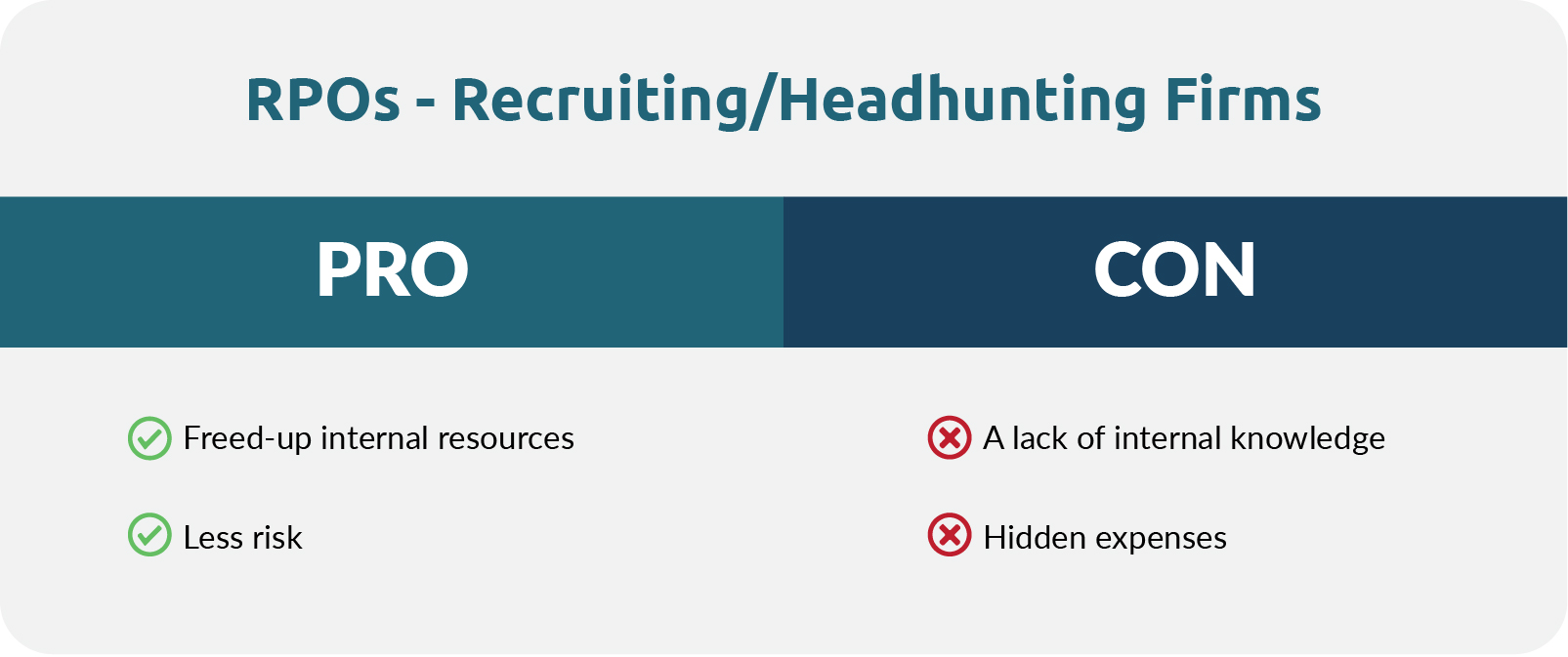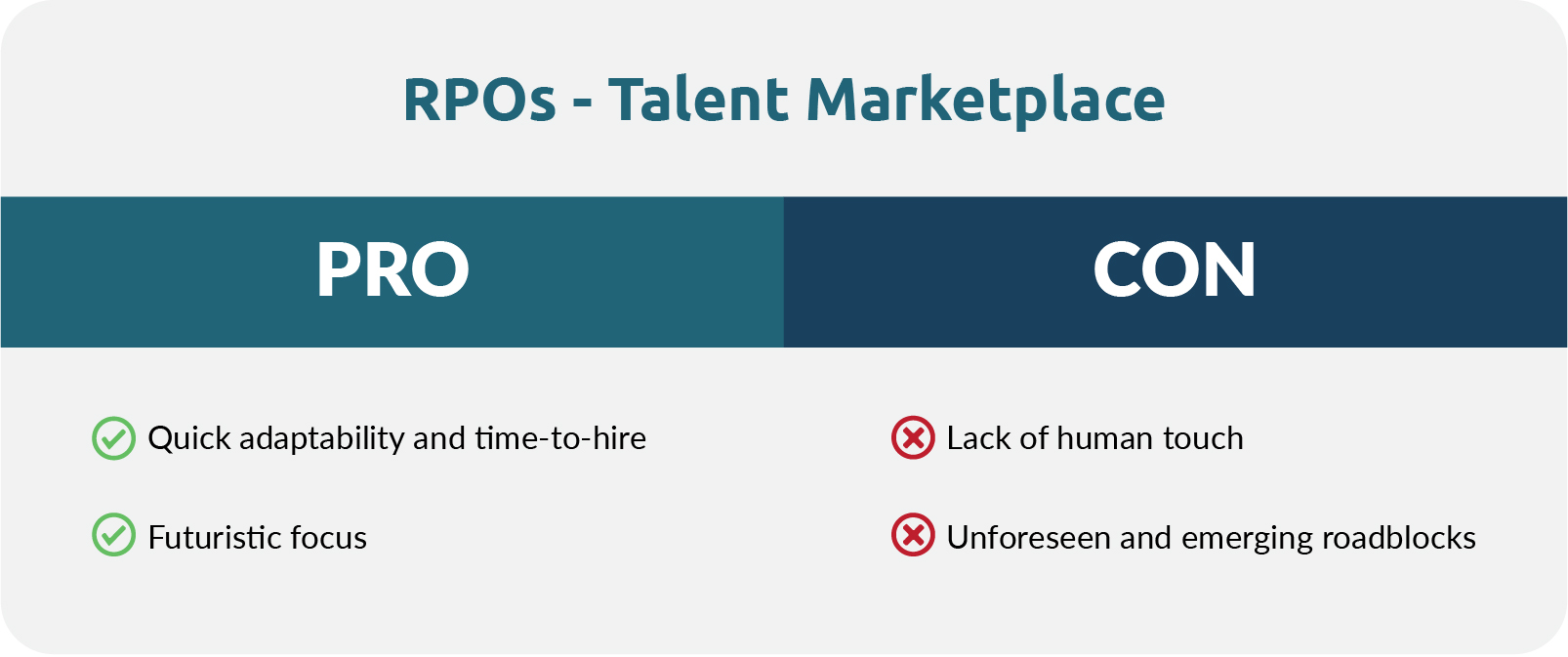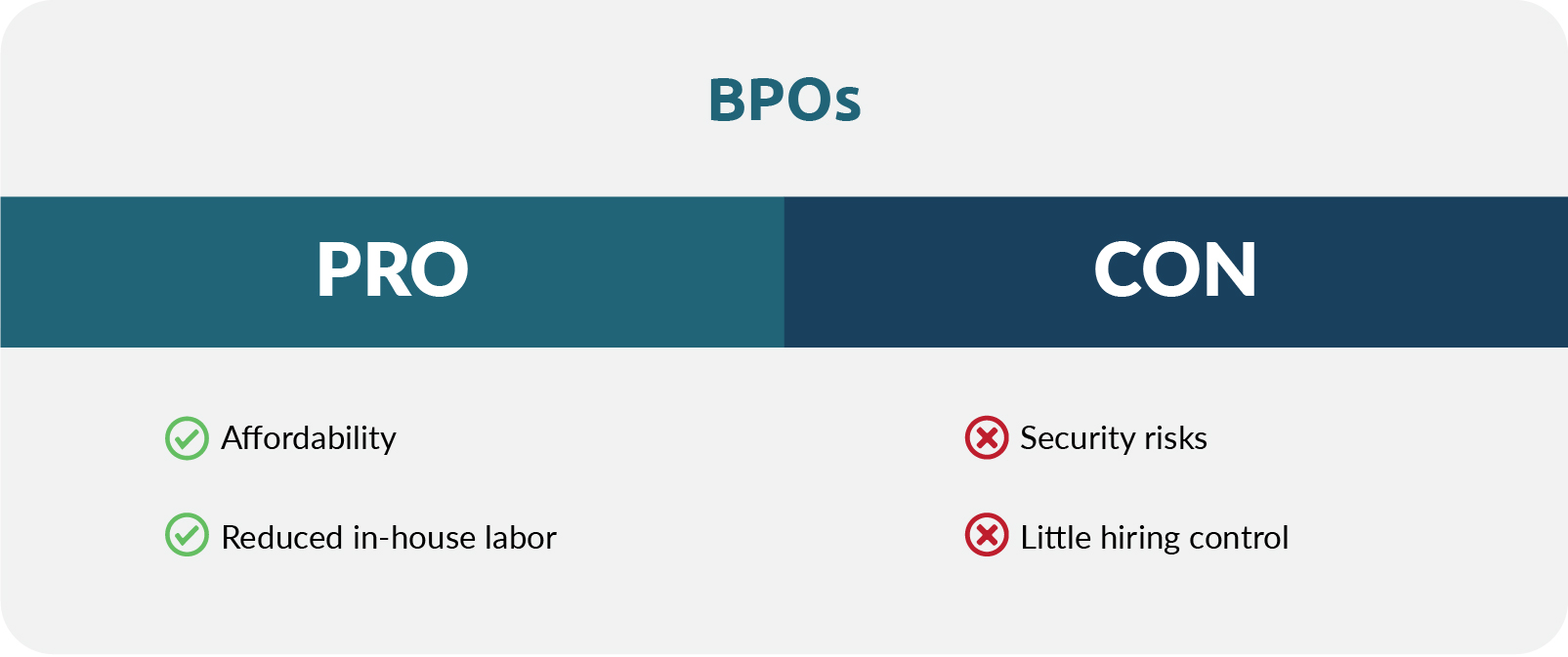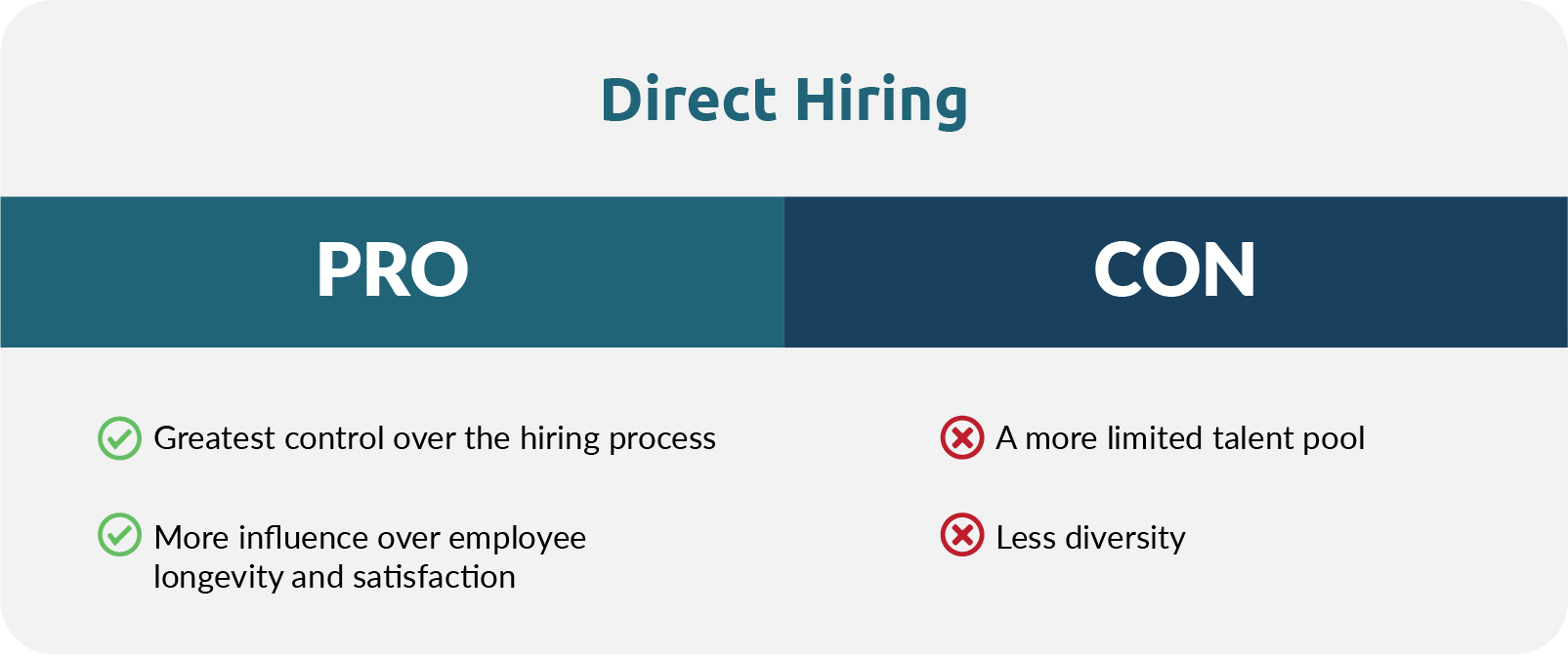As the impact of COVID-19 starts to settle, many companies are re-thinking “business as usual.” Fully distributed teams, a luxury until the recent pandemic, are growing in popularity even as cities and states declare it’s safe to return to work. Companies like Dropbox, Quora, Slack and Amazon continue to challenge the pre-COVID workplace model by proving that finding and hiring top talent, maintaining company culture and achieving optimum results are possible outside the confines of a traditional 9-to-5 on-site office environment. Organizations like those four – and others – offer fully remote options. Some work with outsourcing or third-party companies to assist their direct-hire efforts or apply cutting-edge staffing solutions to age-old challenges.
The Challenge
Thanks to the shattering of the one-size-fits-all approach to workforce hiring practices, more opportunities have arisen for building and drawing from a broader, more diverse talent pool. It has also opened the door for hiring managers to re-examine current talent sourcing, vetting and hiring practices to make sure they find and retain top talent. With more recruiting and staffing solutions available than ever before, identifying a hiring partner to set your business up for increased success is no easy task.
Perhaps exacerbated by job seekers who are now more choosy about work-from-home options, companies are further challenged by hiring plans that are at odds with the current job candidate market – 32% of U.S. employers have reported labor shortages, representing the biggest talent shortage in 15 years. This pressure may send businesses looking for out-of-the-box ways to access and attract talent.
The Solution
The first step in elevating your hiring process is understanding how successful companies build and scale their teams. Today, the most popular approaches include staffing agencies, recruiting firms, BPOs and direct internal hiring processes – but talent marketplaces and other recruitment process outsourcing providers (RPOs) are quickly emerging as alternatives for traditional talent matching, vetting and efforts.
As the talent market continues to evolve, especially post-COVID, and distributed teams and remote work rise in popularity, artificial intelligence plays an increasingly crucial role in hiring efforts and scaling teams. Forbes argues that AI hiring advancements drastically streamline and improve recruiting, amplifying efforts so much they’ve created an entirely new recruitment category concerning how to build a team: on-demand team building. Companies that specialize in on-demand team building may utilize AI or other tech solutions to source, vet and hire qualified candidates more quickly and efficiently.
Table of Contents
Common Hiring Methods: Definitions
Pros and Cons: RPOs – Staffing Agencies
Pros and Cons: RPOs – Recruiting/Headhunting Firms
Pros and Cons: RPOs – Talent Marketplaces
Pros and Cons: BPOs
Pros and Cons: Direct Hiring
Finding the Right Solution
Common Hiring Methods: Pros and Cons
You’ll typically perform a detailed cost/benefit analysis anytime you consider bringing on new team members or building new teams; you should do the same careful research on the method that will best help you source, vet, hire and retain top talent (including new, tech-driven solutions for building and scaling entire teams).
Definitions
Before you can determine the right fit for you, it can help to define each common approach to scaling companies and teams.
RPOs
Recruitment process outsourcing (RPOs) providers generally fall into three categories: staffing agencies, recruiting/headhunting firms and a new, emerging approach: talent and hiring marketplaces.
Staffing Agencies
The middleman between employers and workers, staffing agencies help match qualified candidates with current job openings. The “quick fix” of RPO options, staffing agencies provide job and career opportunities for over 16 million employees a year.
Recruiting Firms/Headhunters
Often confused with staffing agencies, recruiting firms also help match candidates with open roles – but generally source candidates for long-term, full-time management positions instead of the temp or entry-level roles staffing agencies typically focus on.
Talent Marketplace
Whether you’re seeking to fill freelance positions, singular roles or entire teams, talent marketplaces are gaining in popularity. Lighthouse Research & Advisory defines this relatively new service solution as “a way to see projects, needs, and the associated skills, and it allows people to opt-in and fill those gaps [….] and leaders to see the broad skills in demand across the organization.”
BPOs
Business process outsourcing (BPO) providers often focus on building teams by outsourcing back- and front-office operations including HR, accounting, or customer and tech support functions. In addition, many BPOs are located overseas or primarily draw from offshore talent pools, which helps them provide talent at a reduced cost and from a broader, more global talent pool than what is typically accessible to in-house HR teams or staffing agencies.
Direct Hiring
The most traditional way to hire, a direct-hire approach relies on an in-house HR team to maintain a talent pipeline, which is refined until a full-time position can be offered to a candidate. The hires work directly for the company, unlike with BPOs or some managed service talent marketplaces, and internal HR teams do all the work, from sourcing and vetting to hiring and training.
Pros and Cons
Each primary talent sourcing method offers unique benefits and disadvantages when building and growing teams. You can eliminate ill-fitting talent sourcing options by keeping your needs, goals and immediate pain points in mind as you weigh the pros and cons of potential direct-hire and staffing solutions.
RPOs – Staffing Agencies
Staffing agencies typically help fill temporary, short-term or part-time positions in the entry and mid-level range. In addition, they may focus on attracting talent from a specific city or area. While their quick processes and sourcing expertise can make them an attractive consideration for temp or high-volume entry-level roles, they may not be your ideal fit if you’re seeking a talent sourcing partner with proven stability and recruitment processes.

Pros
Expedited vetting and candidate placement
Staffing agencies often work with multiple companies and fill multiple openings at once. Their reach and expanded candidate pool can lead to faster candidate sourcing, vetting and placement. While average in-house hiring methods take 42 days to place candidates, staffing agencies can fill a role in an average of 36 days. Since companies generally turn to staffing agencies to fill temporary, part-time or entry-level positions when considering how to build a team, the cost/benefit ratio can work in your favor: You save valuable internal time and resources that can now be allocated elsewhere.
Sourcing expertise
Unlike an in-house HR team, the sole purpose of staffing agencies is to find, vet and place candidates. They may not intimately know your company or culture. Still, their general industry knowledge, proven experience and multi-faceted, cross-industry teams can add value and expertise – especially if your team lacks the time or resources to broaden expertise in these areas. It’s important to remember, however, that even staffing agencies are typically limited in their geographic reach. At the same time, while they have access to a larger talent pool than your in-house HR team will, it still won’t be as broad of a talent pool as some national or international approaches like talent marketplaces and BPOs.
Cons
Decreased stability
When it comes to building teams, the sweet spot for most staffing agencies is temporary or part-time roles. But these providers may not have the expertise to accurately find and vet candidates seeking long-term employment and growth rather than the next quick opportunity.
Substandard vetting and preparation
Staffing agencies tend to focus on the numbers — customers served and positions filled. Unfortunately, the high-volume approach can lead to poor recruitment and less-qualified candidates as things slip through the cracks to maintain productivity: When there are so many open roles to fill, it can be tough to confirm that your staffing agency has thorough vetting and training processes to ensure the highest-quality talent and team scaling.
RPOs – Recruiting/Headhunting Firms
Sparks Group recommends working with recruitment agencies (also called headhunters) to invest in top-quality employees for long-term needs. This route can free up resources and minimize risk. But don’t underestimate the challenges, like misaligned perspectives and hidden costs.

Pros
Freed-up internal resources
As with staffing agencies, recruiters’ main goal is to match qualified candidates with long-term, full-time roles. Having these essential HR functions handled by a third-party hiring professional frees up your internal team to focus on other demands.
Less risk
Recruiting firms require strict contracts to work with a company on filling roles. By outlining the professional obligations of both parties, these contracts protect you from last-minute candidate withdrawals, contractual differences and other difficulties that could arise.
Cons
A lack of internal knowledge
Though any thorough outsourcing partner will strive to learn as much as possible about your team, culture and ideal candidate, their external perspective only goes so far. For many businesses, especially those that understand the effects of work culture on employee engagement and a healthy work environment, it’s crucial to explain your business’ culture, expectations and work style to any candidate – especially one you’re seriously considering. Unfortunately, not every recruiting firm can do this well.
Hidden expenses
Hidden expenses are a potential problem for all outsourcing methods, but – perhaps arguably – it can come up most frequently with recruitment firms. While their initial contracts may seem simple, recruiters and third-party hiring partners can bring unexpected, hidden costs as the partnership plays out. If positions are filled slowly or require additional vetting or more interviews than originally anticipated, finder’s fees, vetting costs and other expenses can quickly add up.
RPOs – Talent Marketplace
The newest player in the talent sourcing game, talent marketplaces usually leverage software and automated matching processes to connect professionals with employment opportunities. Their quick change management, adaptability and forward-thinking business model make them the workforce sourcing method of the future – especially for the remote environment and quickly scaling teams – but their lack of human involvement and unknown or emerging roadblocks can deter possible partnerships.

Pros
Quick adaptability and time-to-hire
Effective navigation and understanding of talent marketplaces empowers your company to effectively build, manage and scale teams. This adaptability is key — especially for remote-first companies — as you meet increased demands and greet the flexible, post-COVID-19 marketplace with confidence.
Futuristic focus
Over 4 million Americans work from home at least half the time: Tech-enabled talent marketplaces take advantage of new technologies to make this work-from-home opportunities accessible to more people, widening the global talent pool and increasing your odds of finding the best candidate.
Cons
Lack of human touch
While tech-enabled talent marketplaces can adapt with your business, easily carrying you into the future of work, the tech focus (and corresponding lack of human involvement) can be difficult to adjust to. Machine learning, while evolving, lacks empathy and emotion — both key elements of choosing and building a team. Your ideal talent should utilize cutting-edge tools while still understanding the value the right people and expertise can add to your hiring process.
Unforeseen and emerging roadblocks
On-demand talent solutions in the shape of tech-enabled talent marketplaces are already shaping the workforce of the future. Other ways that teach you how to build a team – like considering hybrid or remote work options – and work/life balance are more crucial than ever before. However, one potential con of this new option is just that: it’s new! Challenges, roadblocks, and problems with this model may emerge with time, and companies should be poised to adapt as this approach naturally evolves.
BPOs
The general affordability and reduced in-house labor costs associated with BPO partnerships might make them an attractive option, but are increased security risks and loss of hiring control worth the benefits? Let’s find out.

Pros
Affordability
Generally speaking, BPOs are more affordable thanks to their large workforces, efficient — sometimes overseas — operations and simplified processes. These advantages are ideal for companies with extensive call or customer assistance centers, 24/7 operations or question/answer services.
Reduced in-house labor
Hiring, staffing and training are expensive processes for any company, especially on larger customer or operations support and service teams. Outsourcing these functions is an ideal way to reduce spending and increase cost savings.
Cons
Security risks
Companies subject to HIPAA regulations (e.g., telehealth or medtech), or those that handle banking or other personal information, must protect their customers’ privacy. When you offshore customer support and operations with BPOs, you may have less control over data and an increased risk of data breaches if you’ve turned to the wrong partner. If you’re subject to U.S. privacy and security regulations, make sure the team handling any regulated data is authorized to work in the United States.
Little hiring control
Overseas companies vet, hire and retain at will. As a third-party customer, BPOs offer little to no control over the professionals assigned to your account, and little accountability if anything happens. By trusting BPOs, you give up internal control, perhaps even more so when partnering with offshore BPOs, where communication issues, language differences and off-peak working hours can pose additional challenges for both new and growing teams.
Direct Hiring
Direct hiring gives you more control over the hiring process, which can have greater influence over employee lifespan and satisfaction. However, limited management control, talent pools and lack of diversity can hinder success with this type of talent sourcing.

Pros
Greatest control over the hiring process
When your in-house HR team finds, vets and hires internal employees themselves, you can retain total control over how to build a team and strengthen your hiring process. Intimate interaction with every candidate gives you better insight into who might be the best fit for your existing team.
More influence over employee longevity and satisfaction
Internal roles often come with health, retirement and other benefits. These incentives, and the passion communicated by the internal HR team during the hiring process, may give candidates motivation to stay with a company for long periods, grow their skills and lend their expertise to your organization. It can be all-too-common for external hires, scaling teams or outsourced team members to lack this passion – especially without the long-term benefits or work culture internal teams typically enjoy.
Cons
A more limited talent pool
HR managers, especially those hiring for in-person or local roles, are often limited to considering candidates in their vicinity. Limited talent pools can unintentionally keep you from accessing more diverse, top-tier talent.
Less diversity
Unconscious hiring bias exists: Unfortunately, it’s more likely to come into play with a small, internal hiring team. As diverse and inclusive hiring practices become increasingly important, more teams seek external solutions to increase their efforts and hire more intentionally.
Finding Your Ideal Hiring Solution
Though each hiring solution offers unique advantages, finding your ideal talent sourcing fit goes beyond checking boxes or finding the quickest fit. Use these questions to help your team think critically about how the ideal talent partner can best meet your needs and add additional value to your teams.
Team Growth Considerations: Questions To Ask
- Where is my company heading? Back to the office? Fully remote? Somewhere in between?
- How many team members do I need?
- What talent sourcing model can best adapt and scale with us?
- Do I have the resources for direct hiring? If not, which external option best fits my budget?
- What values are most important to my team in a potential talent partner?
- How do I expect my company to grow/change within the next five years?
- Is it essential that all team members be internal employees?
- How does company culture affect my hiring practice? How would I want a talent partner to contribute to this?
Remote Talent Sourcing Solutions: Building the Workforce of the Future
Is your company growing beyond what its current workforce can handle? Maybe your current talent partner is no longer performing as it should, or you just don’t feel equipped to succeed in the remote shift quickly overtaking the marketplace.
Whatever the reason for re-examining your current talent sourcing and hiring solutions, finding the right talent partner can be crucial to your future success. Consider this guide a resource as you compare and contrast possible partnerships to better understand the challenges your ideal talent sourcing model would solve and help make your best choice. Think there’s another direct hiring or staffing solution we didn’t include, but should? Let us know!
